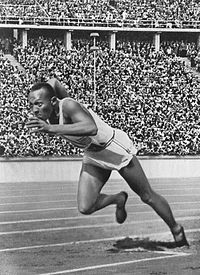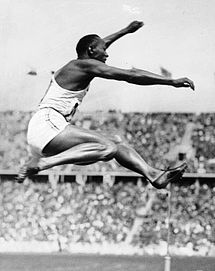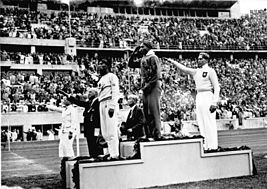
Jesse Owens
About this schools Wikipedia selection
Arranging a Wikipedia selection for schools in the developing world without internet was an initiative by SOS Children. Click here to find out about child sponsorship.
 Jesse Owens in 1936 |
||||||||||||||||||||||
| Personal information | ||||||||||||||||||||||
|---|---|---|---|---|---|---|---|---|---|---|---|---|---|---|---|---|---|---|---|---|---|---|
| Full name | James Cleveland Owens | |||||||||||||||||||||
| Nationality | American | |||||||||||||||||||||
| Born | September 12, 1913 Oakville, Alabama, USA |
|||||||||||||||||||||
| Died | March 31, 1980 (aged 66) Tucson, Arizona, USA |
|||||||||||||||||||||
| Height | 5 ft 10 in (1.78 m) | |||||||||||||||||||||
| Weight | 165 lb (75 kg) | |||||||||||||||||||||
| Sport | ||||||||||||||||||||||
| Sport | Track and field athletics | |||||||||||||||||||||
| Event(s) | Sprint, Long jump | |||||||||||||||||||||
|
Medal record
|
||||||||||||||||||||||
James Cleveland "Jesse" Owens (September 12, 1913 – March 31, 1980) was an American track and field athlete who specialized in the sprints and the long jump. He participated in the 1936 Summer Olympics in Berlin, Germany, where he achieved international fame by winning four gold medals: one each in the 100 meters, the 200 meters, the long jump, and as part of the 4x100 meter relay team. He was the most successful athlete at the 1936 Summer Olympics.
The Jesse Owens Award, USA Track and Field's highest accolade for the year's best track and field athlete, is named after him, in honour of his significant career.
Childhood
Owens was the youngest of ten children, three girls and seven boys, born to Henry Cleveland Owens and Mary Emma Fitzgerald in Oakville, Alabama on September 12, 1913. J.C., as he was called, was nine years old when the family moved to Cleveland, Ohio for better opportunities, as part of the Great Migration, when 1.5 million African Americans left the segregated South. When his new teacher asked his name (to enter in her roll book), he said "J.C.", but because of his strong Southern accent, she thought he said "Jesse". The name took, and he was known as Jesse Owens for the rest of his life.
As a boy and youth, Owens took different jobs in his spare time: he delivered groceries, loaded freight cars and worked in a shoe repair shop while his father and older brother worked at a steel mill. During this period, Owens realized that he had a passion for running. Throughout his life, Owens attributed the success of his athletic career to the encouragement of Charles Riley, his junior high track coach at Fairmount Junior High School. Since Owens worked in a shoe repair shop after school, Riley allowed him to practice before school instead.
Owens first came to national attention when he was a student of East Technical High School in Cleveland; he equalled the world record of 9.4 seconds in the 100-yard (91 m) dash and long-jumped 24 feet 9 1⁄2 inches (7.56 metres) at the 1933 National High School Championship in Chicago.
Ohio State University
Owens attended Ohio State University after employment was found for his father, ensuring the family could be supported. Affectionately known as the "Buckeye Bullet," Owens won a record eight individual NCAA championships, four each in 1935 and 1936. (The record of four gold medals at the NCAA was equaled only by Xavier Carter in 2006, although his many titles also included relay medals.) Though Owens enjoyed athletic success, he had to live off campus with other African-American athletes. When he traveled with the team, Owens was restricted to ordering carry-out or eating at "black-only" restaurants. Similarly, he had to stay at "blacks-only" hotels. Owens did not receive a scholarship for his efforts, so he continued to work part-time jobs to pay for school.
Owens's greatest achievement came in a span of 45 minutes on May 25, 1935, during the Big Ten meet at Ferry Field in Ann Arbor, Michigan, where he set three world records and tied a fourth. He equaled the world record for the 100 yard dash (9.4 seconds); and set world records in the long jump (26 ft 8 1⁄4 in/8.13 m, a world record that would last 25 years); 220-yard (201.2 m) sprint (20.3 seconds); and 220-yard (201.2m) low hurdles (22.6 seconds, becoming the first to break 23 seconds). In 2005, University of Central Florida professor of sports history Richard C. Crepeau chose these wins on one day as the most impressive athletic achievement since 1850.
Berlin Olympics
In 1936, Owens arrived in Berlin to compete for the United States in the Summer Olympics. Adolf Hitler was using the games to show the world a resurgent Nazi Germany. He and other government officials had high hopes that German athletes would dominate the games with victories (the German athletes achieved a "top of the table" medal haul). Meanwhile, Nazi propaganda promoted concepts of " Aryan racial superiority" and depicted ethnic Africans as inferior.
Owens surprised many by winning four gold medals: On August 3, 1936, he won the 100m sprint, defeating Ralph Metcalfe; on August 4, the long jump (later crediting friendly and helpful advice from Luz Long, the German competitor he ultimately defeated); on August 5, the 200m sprint; and, after he was added to the 4 x 100 m relay team, following a request by the Germans to replace a Jewish-American sprinter, he won his fourth on August 9 (a performance not equaled until Carl Lewis won gold medals in the same events at the 1984 Summer Olympics).
Just before the competitions, Owens was visited in the Olympic village by Adi Dassler, the founder of the Adidas athletic shoe company. He persuaded Owens to use Gebrüder Dassler Schuhfabrik shoes, the first sponsorship for a male African-American athlete.
The long-jump victory is documented, along with many other 1936 events, in the 1938 film Olympia by Leni Riefenstahl.
On the first day, Hitler shook hands only with the German victors and then left the stadium. Olympic committee officials insisted Hitler greet every medalist or none at all. Hitler opted for the latter and skipped all further medal presentations. On reports that Hitler had deliberately avoided acknowledging his victories, and had refused to shake his hand, Owens said at the time:
"Hitler had a certain time to come to the stadium and a certain time to leave." "It happened he had to leave before the victory ceremony after the 100 meters. But before he left I was on my way to a broadcast and passed near his box. He waved at me and I waved back. I think it was bad taste to criticize the 'man of the hour' in another country."
Away from the public eye, Hitler expressed his true feelings and disgust at Owens. Albert Speer, Hitler's architect and later war armaments minister, later recollected in his memoirs:
Each of the German victories, and there were a surprising number of these, made him happy, but he was highly annoyed by the series of triumphs by the marvelous colored American runner, Jesse Owens. People whose antecedents came from the jungle were primitive, Hitler said with a shrug; their physiques were stronger than those of civilized whites and hence should be excluded from future games.
Owens was allowed to travel with and stay in the same hotels in Germany as whites, while at the time blacks in many parts of the United States had to stay in segregated hotels while traveling. After a New York City ticker-tape parade of Fifth Avenue in his honour, Owens had to ride the freight elevator at the Waldorf-Astoria to reach the reception honoring him.
Owens said, "Hitler didn't snub me – it was FDR who snubbed me. The president didn't even send me a telegram." On the other hand, Hitler sent Owens a commemorative inscribed cabinet photograph of himself. Jesse Owens was never invited to the White House nor were honours bestowed upon him by President Franklin D. Roosevelt (FDR) or his successor Harry S. Truman during their terms. In 1955, President Dwight D. Eisenhower (himself an athlete of note) honored Owens by naming him an "Ambassador of Sports."
Legacy
The dormitory used by Owens during the Olympics has been fully restored into a living museum, with pictures of his accomplishments at the Games, and a letter (intercepted by the Gestapo) from a fan urging him not to shake hands with Hitler.
Post-Olympics
He was quoted saying the secret behind his success was “I let my feet spend as little time on the ground as possible. From the air, fast down, and from the ground, fast up.”
After the games had finished, the Olympic team and Owens were all invited to compete in Sweden. He decided to capitalize on his success by returning to the United States to take up some of the more lucrative commercial offers. United States athletic officials were furious and withdrew his amateur status, ending his career immediately. Owens was angry, saying, "A fellow desires something for himself."
Prohibited from amateur sporting appearances to bolster his profile, Owens found the commercial offers all but disappeared. In 1946, he joined Abe Saperstein in the formation of the West Coast Baseball Association (WCBA), a new Negro baseball league; Owens was Vice-President and the owner of the Portland (Oregon) Rosebuds franchise. He toured with the Rosebuds, sometimes entertaining the audience in between doubleheader games by competing in races against horses. The WCBA disbanded after only two months.
Owens helped promote the exploitation film Mom and Dad in black neighborhoods. He tried to make a living as a sports promoter, essentially an entertainer. He would give local sprinters a ten- or twenty-yard start and beat them in the 100-yd (91-m) dash. He also challenged and defeated racehorses; as he revealed later, the trick was to race a high-strung thoroughbred that would be frightened by the starter's shotgun and give him a bad jump. Owens said, "People say that it was degrading for an Olympic champion to run against a horse, but what was I supposed to do? I had four gold medals, but you can't eat four gold medals."
Owens ran a dry cleaning business and worked as a gas station attendant to earn a living. He eventually filed for bankruptcy. In 1966, he was successfully prosecuted for tax evasion. At rock bottom, he was aided in beginning rehabilitation. The government appointed him a US goodwill ambassador. Owens traveled the world and spoke to companies such as the Ford Motor Company and stakeholders such as the United States Olympic Committee. After he retired, he owned racehorses.
Owens initially refused to support the black power salute by African-American sprinters Tommie Smith and John Carlos at the 1968 Summer Olympics. He told them:
The black fist is a meaningless symbol. When you open it, you have nothing but fingers – weak, empty fingers. The only time the black fist has significance is when there's money inside. There's where the power lies.
Four years later in his 1972 book I Have Changed, he moderated his opinion:
I realized now that militancy in the best sense of the word was the only answer where the black man was concerned, that any black man who wasn't a militant in 1970 was either blind or a coward.
A few months before his death, Owens had tried unsuccessfully to convince President Jimmy Carter not to boycott the 1980 Moscow Olympics. He argued that the Olympic ideal was to be a time-out from war and above politics.
Marriage and family
Owens and Minnie Ruth Solomon met at Fairmount Junior High School in Cleveland when he was 15 years old and she was 13 years old. They dated steadily through high school. Ruth gave birth to their first daughter, Gloria, in 1932. They married in 1935 and had two more daughters together: Marlene, born in 1939, and Beverly, born in 1940. They remained married until his death.
Death
Owens, a pack-a-day cigarette smoker for 35 years, had been hospitalized with an extremely aggressive and drug-resistant type of lung cancer on and off beginning in December 1979. He died in Tucson, Arizona, on March 31, 1980, with his wife and other family members at his bedside. He is buried in Oak Woods Cemetery in Chicago.
Awards, tributes and honours
- In 1936, four English Oak saplings, one for each Olympic gold medal, from the German Olympic Committee. One of the trees was planted at the University of Southern California, one at Rhodes High School in Cleveland, OH where he trained, and one is rumored to be located on the Ohio State University campus, but has yet to be identified. The fourth tree was located at the home of Jess Owens' mother, but was removed when the house was demolished.
- In 1970, Owens was inducted to the Alabama Sports Hall of Fame.
- In 1976 he was awarded the Presidential Medal of Freedom by President Gerald Ford.
- In 1976, he was made part of the Olympic Order for his fight against racism in the 1936 Olympics in Berlin.
- In 1980, a new asteroid was discovered by Antonín Mrkos at Kleť Observatory which was named as 6758 Jesseowens in honour of Jesse Owens.
- USA Track and Field created the Jesse Owens Award in 1981, which is given annually to the country's top track and field athlete.
- In 1984, an Emmy Award-winning biographical television film of his life, The Jesse Owens Story, was released, with Dorian Harewood portraying Owens.
- In 1984 a street near the Olympic Stadium in Berlin was renamed Jesse-Owens-Allee, and the Jesse Owens Realschule/Oberschule (a secondary school) in Berlin-Lichtenberg, was named for him.
- In 1988, he was portrayed in King of the Olympics: The Lives and Loves of Avery Brundage by Ronnie Britton.
- On March 28, 1990, Owens was posthumously awarded the Congressional Gold Medal by President George H. W. Bush.
- Two U.S. postage stamps have been issued to honour Owens, one in 1990 and another in 1998.
- In 1996, Owens's hometown of Oakville, Alabama, dedicated Jesse Owens Memorial Park in his honour, at the same time that the Olympic Torch came through the community, 60 years after his Olympic triumph. An article in the Wall Street Journal of June 7, 1996, covered the event and included this inscription written by poet Charles Ghigna that appears on a bronze plaque at the Park:
- May this light shine forever
- as a symbol to all who run
- for the freedom of sport,
- for the spirit of humanity,
- for the memory of Jesse Owens.
- In 2001, The Ohio State University dedicated Jesse Owens Memorial Stadium for track and field events. The campus also houses three recreational centers for students and staff named in his honour.
- In 2002, scholar Molefi Kete Asante listed Jesse Owens on his list of 100 Greatest African Americans.
- In Cleveland, Ohio, a statue of Owens in his Ohio State track suit was installed at Fort Huntington Park, west of the old Courthouse.
- Phoenix, Arizona named the Jesse Owens Medical Plaza in his honour, as well as Jesse Owens Parkway.
- In Markus Zusak's 2006 hit, The Book Thief, a character named Rudy Steiner covers himself with charcoal and runs 100 meters at the local sporting field. This was known around Rudy's neighbourhood as the "Jesse Owens" incident. Later in the book when he dies, protagonist Liesel Meminger calls him "Jesse Owens" in her attempts to revive him.
- Jesse Owens Park, located in Tucson, Arizona, is a staple of local youth athletics there.
- At the 2009 World Athletic Championships in Berlin, all members of the United States Track & Field team wore badges with "JO" to commemorate Owens's victories in the same stadium 73 years before.
- In early 2010, the Ohio Historical Society proposed Jesse Owens as a finalist from a statewide vote for inclusion in Statuary Hall at the United States Capitol.
- On Monday, November 15, 2010, the city of Cleveland renamed East Roadway, between Rockwell and Superior avenues in Public Square, Jesse Owens Way, in hopes that it will keep the great Jesse Owens on the minds of all sports fans.
- A novel in French written by Lebanese novelist Alexandre Najjar, Berlin 36, Plon (publisher), Paris, 2009, tells the story of Owens, particularly during the Berlin Olympic games. Najjar visited Chicago, Ohio and Alabama to achieve this distinguished tribute to Owens.
- For his contribution to sports in Los Angeles, he was honored with a Los Angeles Memorial Coliseum "Court of Honour" plaque by the Coliseum commissioners.
- In the London 2012 Summer Olympics opening ceremony, just after the Olympic cauldron had been lit, the 80,000 individual pixels in the audience seating area were used as a giant video screen to show footage of Owens running around the stadium.


